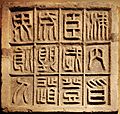Imperial China facts for kids
Imperial China is a period of Chinese history. It lasted over 2,000 years. It began with Qin Shi Huang's uniting of China under the Qin dynasty in 221 BC. It ended with the overthrow of the Qing dynasty in 1911. Throughout this period, many features of Chinese civilization spread throughout all of China. These included Confucianism, standardized testing, standardized weights and counting systems, trade routes, and Chinese characters. China became known worldwide for all these features.
Throughout this period, China had been ruled by many different dynasties, or ruling family lines. They included the Qin, Han, Sui, Tang, Song, Yuan/Mongol, Ming, and Qing/Manchu dynasties. There were also several periods where China had been ruled by several different kingdoms.
Throughout most of Imperial China, China had been ruled by emperors and empresses who were Han Chinese. However, there were some dynasties where the ruling class was made of Chinese minority groups, such as the Yuan and Qing dynasties. They were ruled by the Mongols and Manchus in that same order.
Images for kids
-
Approximate territories occupied by the various dynasties and states throughout the history of China
-
Ding vessels had its origins in standard ceramic vessels. A Lidded Ding with Interlaced Dragons from Middle Eastern Zhou dynasty, late Spring and Autumn or early Warring States period, about 500-450 BC
-
The Tsinghua Bamboo Slips, containing the world's earliest decimal multiplication table, dated 305 BC
-
Han dynasty hat
-
Stone slab with twelve Qin seal characters (221–206 BC)
-
The People's Liberation Army enters Beijing in the Pingjin Campaign
-
Chairman Mao Zedong proclaiming the establishment of the People's Republic of China in 1949.


















